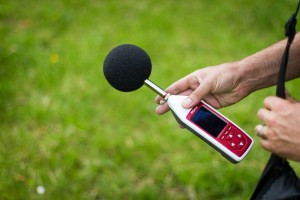Glastonbury Festival case study
 END USER: Richard Willson, Noise at Work Consultant for TESS, The Event Safety Shop.
END USER: Richard Willson, Noise at Work Consultant for TESS, The Event Safety Shop.
Richard is one of the UK’s most experienced Festival noise specialists having worked on some of the UK’s most prestigious events such as Glastonbury, Latitude, Leeds & Reading Festivals, Festival Republic and BBC events.
LOCATION: 2014 Glastonbury Festival, Pilton, Somerset.
APPLICATION: Ensuring Noise at Work Regulations 2005 and noise limits were monitored and adhered to ensure the well being of Festival employees and concession staff during the 5 day music and performing arts festival.
ISSUES: The sheer size of Glastonbury covering some 900 acres as the largest Greenfield festival in the world, posed a challenge with Richard employing some innovative tactics to ensure his noise measurements were accurate and valid. With 200,000 festival goers and approximately 60,000 staff on site, Richard also had to use all of his negotiating skills to enforce compliance and understanding of noise levels as a serious health issue.
EQUIPMENT USED:
- 10x doseBadge
- 1x Optimus Red sound level meter
THE PROJECT in Richard’s words:
“Recent changes to the Noise at Work regulations meant that they now apply to festivals so my work begins with a visual survey of the site to pinpoint where we see a need for ear protection in noise hot spots and estimate how many staff will need ear plugs or other protection. We aim to have over 70% compliance as a general rule of thumb at any one time and this would cover everyone from festival staff, traders and concession employees.
“Using the data, we create a noise map of the site and then work up red, amber and green zones which range from constant noise levels that require mandatory ear protection to be worn, through to warnings of intermittent excess noise or low risk areas.
“You have some areas that are obvious red zones such as The Pit at the front of the stage where security and medical staff are based. Normally, a Festival will start around 11am and go through to maybe 1am the following morning. There is some down time when the roadies are changing sets but other than that there will be very high noise levels in this area and anyone based there will be suffering from long term exposure. Fortunately the security staff are very experienced and understand the risks. Roadies and the musicians are also at risk, so much so, their jobs are listed as one of the top 5 noisiest in the UK – that’s alongside jobs such as airport ground staff and construction workers.
“The awareness of noise is increasing but we still have issues persuading other personnel on the site of the risks of noise levels for their staff, for example, with some of the bar concessions further away from the main stage but who have their own sound and PA systems in confined spaces.
“We understand that they want to have the music on loud to create an ambience and attract people in but they also have to understand the damage it can cause to people’s hearing. Hearing damage and loss is a very serious condition and sufferers of tinnitus have been known to commit suicide because of the misery it causes. With this kind of situation we have to negotiate and persuade, but we also understand it is problematic if bar staff wearing ear plugs who can’t hear the customers properly. The data we collect from the doseBadge and using the Optimus Red sound level meter gives us the evidence we need to make the case and we are able to show the high level readings and come up with a solution.
“At this type of Festival, you can regularly expect noise levels to exceed 110 dBA and you need to understand the risks that brings. Having said phentermine 37.5 mg a 159 that, you also need to be aware of the variances expected during a festival day or weekend. You wouldn’t expect Dolly Parton on the main stage who would be quite mellow to be as loud as, say, Metallica. There has to be a lot of common sense applied.
“But every festival is different and the sheer size of Glastonbury poses a problem. It might take me two hours just to walk around the site to put the doseBadges in place. We then need at least six hours of recordings and then it would take me another two hours to go around and collect them all in again before we can download and analyse the results.
“Fortunately, having used the doseBadge and Optimus Red for several years now I know they are very robust and they have never failed on me. I have to leave the doseBadges in all kinds of places around the site, but they work in all weathers – very handy with the British summers! The screens and readings are easy to see, whether it is in during the day or getting on into the evening; which is important as we take readings at all times of the day and night. The software is also very user friendly and simple to operate which is important as you need a really quick way to get the job done, often working at breakneck speed.
“Overall, festival management are becoming more aware of the Noise at Work regulations and how it applies to their event. They need to be able to understand the data we collate and see it as clear evidence. The same applies for Local Authorities who are pushing compliance more and more at these type of events as they take place within their region.”
Glastonbury Facts:
- Size – 900 acres
- Perimeter – 8.5miles
- Capacity of Pyramid/Main stage area – 90,000
- Market Stalls – 755
- Toilets – 5,487
- First Festival – In 1970 saw 1,500 enjoyed free entry. Headliners were T-Rex
- This grew to 12,000 in 1971. From 1979, it became a three-day affair and attendance increased year by year until passing the 100,000 mark in 1998.
- During the 1980s and early 90s, Glastonbury attracted large numbers but as the festival grew, its dynamic shifted and free admission ended.
- All 135,000 tickets for 2013 sold out in 1 hour 40 minutes.
TECHNICAL INFORMATION:
THE DOSEBADGE NOISE DOSIMETER
- The doseBadge is the original wireless personal noise dosimeter. It is the ideal tool to carry out occupational and industrial hygiene noise measurements and provides a unique solution for these applications.
- Combining an innovative design with simple, robust and reliable operation, the doseBadge weighs only 51g/1.8oz.
- With no cables, controls or displays, the doseBadge can be worn in areas where there is a risk of damaging traditional style units or where there is a risk of tampering.
- Designed and manufactured by Cirrus Research plc, the doseBadge is an innovative instrument that is ideal for measuring and assessing the noise exposure of workers and employees across all locations.
- NoiseTools Analysis & Reporting software with licence-free installation & free lifetime updates
- 90 minute (typical) charge time with 24 hours (typical) battery life
OPTIMUS RED SOUND LEVEL METER
The optimus red sound level meters use the very latest digital technology and industrial design to give you the ideal instrument for Occupational and Industrial Hygiene noise measurements. There is no setup or complicated configuration needed. Just switch on, calibrate and press start.
- A range of high performance Class 1 & Class 2 Sound Level Meters
- Designed for Noise at Work, Occupational Noise & Industrial Hygiene to UK, EU, OSHA,MSHA or ACGIH standards
- Optional 1:1 Octave Band Filters
- Optional data logging with 4GB of memory (32GB option)
- Option of NR & NC Curves
- Simultaneous measurement of all available parameters
- High resolution colour OLED display with backlit keypad
- Lightweight, ergonomic design
- VoiceTag™ voice note recording
- AuditStore™ measurement verification




